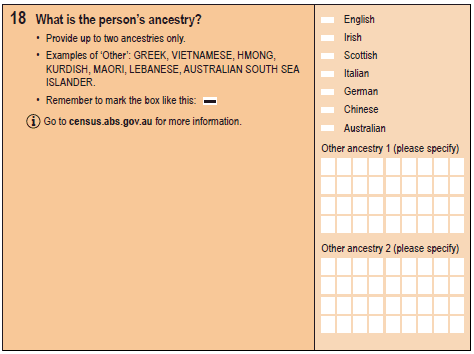ANCESTRY
This topic provides a self-assessed measure of ethnic origin or cultural group affiliation. A person's ancestry, in conjunction with their country of birth and information on birthplace of parents, assists in indicating ethnic origin or cultural group affiliations of first and second generation Australians. Used in conjunction with other indicators of cultural and linguistic diversity the Ancestry topic can help inform the delivery of services and programs to particular ethnic communities. Up to two ancestries can be provided on the Census form.
BACKGROUND
A question on each person's ancestry (i.e. ethnic origin or cultural group), was asked for the first time in the 1986 Census. The question was designed to identify the respondent's ethnic origin (an ancestry concept) rather than a self-identification approach. The aim of the question was to measure the ethnic composition of the population as a whole. Evaluations showed that there was a level of subjectivity about how people interpreted and responded to the question. Little use was made of the ancestry data from the 1986 Census, and there was no question on ancestry in either the 1991 or 1996 Censuses.
As a result of user demand, the ABS established a Census Consultative Group on Ancestry in 1995 to seek input to identify user requirements for this data, research international practices and develop questions that produced more accurate data at reasonable cost. The Consultative Group identified that there were major policy issues for those people who either were born overseas or who were Australian born to parents who were born overseas. For this reason it was determined an Ancestry question in combination with a question on whether the person's parents were born in Australia or overseas would produce data of acceptable quality.
A question on ancestry has been included in each Australian Census since 2001. An Ancestry Consultative Committee was again established in June 2003 to review the questions on ancestry and country of birth of parents for the 2006 Census. An outcome from the review recommended that these questions be asked in a similar format to that used in the 2001 Census. This format was retained for the 2006 and 2011 Censuses.
During the 2016 Census consultation period, the Ancestry topic was reviewed again in the context of demand for more detailed information on country of birth of parents. User feedback indicated support for the collection of this topic on a five yearly cycle. This question will be asked again in the 2016 Census but with a changed layout which will provide two distinct areas in which people can write in an ancestry that is not one of the pick box ancestries. This change is to clarify responses and improve autocoding rates. When writing more than one ancestry in a single area, people tended to add marks such as backslashes or hyphens between them, which made the entries fail autocoding and left their intended answer unclear.
The value of this data will be enhanced through the concurrent collection of detailed country of birth of parents information in the 2016 Census.
As in 2006 and 2011, responses to this question for the 2016 Census will be coded to the 2005-06 edition of Australian Standard Classification of Cultural and Ethnic Groups (ASCCEG) (cat. no. 1249.0).
QUESTION
The following question is from the paper 2016 Census Household Form.

 Print Page
Print Page
 Print All
Print All